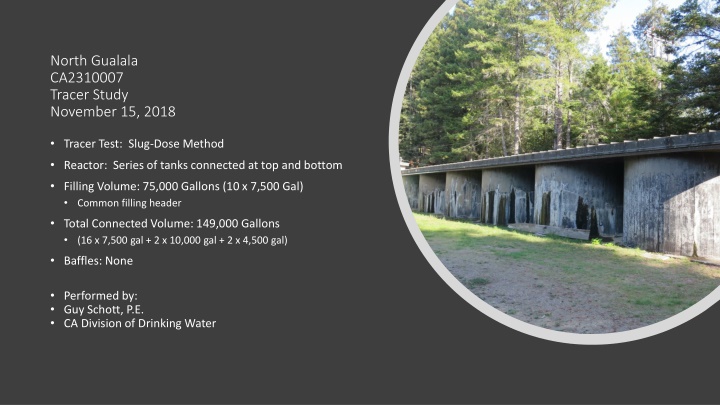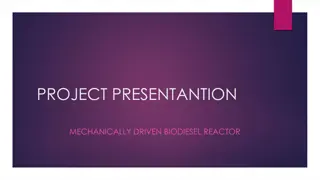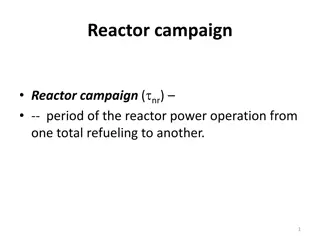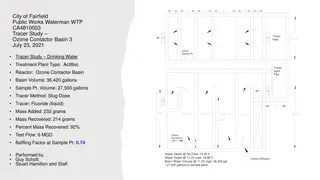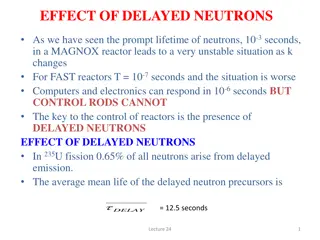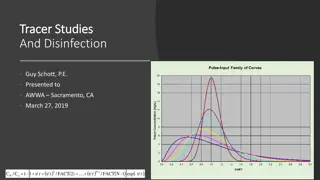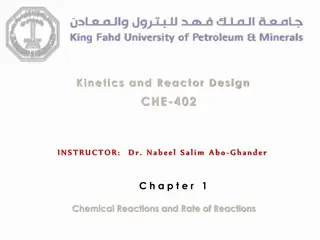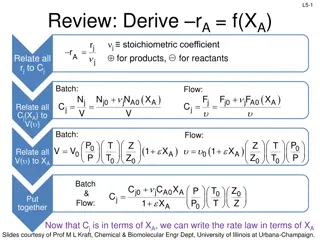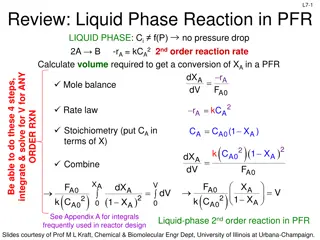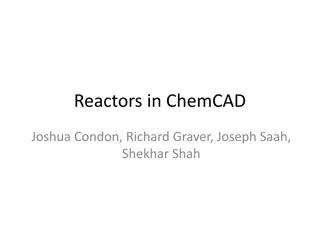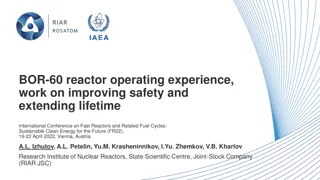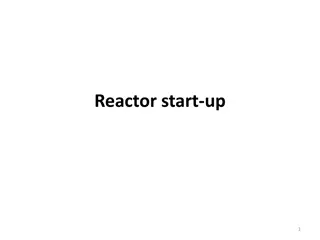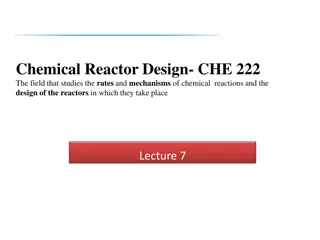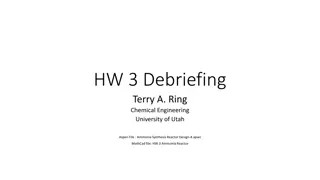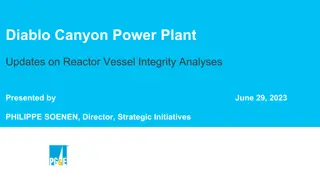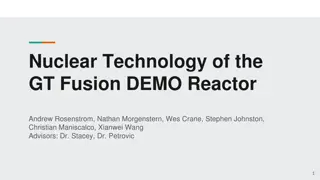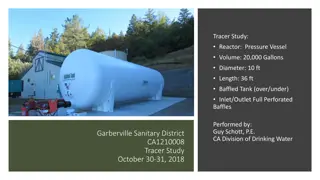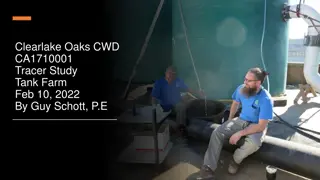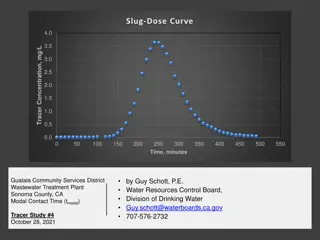Tracer Study of Reactor Design in North Gualala, CA - November 15, 2018
Tracer study conducted in North Gualala, CA on November 15, 2018, focused on the reactor design using the modified Slug-Dose method. The study involved a series of interconnected tanks with a total connected volume of 149,000 gallons. Tracer testing included the addition of Fluoride as the tracer, with resulting recovery rates at t10 and 4 hours after testing. Detailed test results and analysis of tracer concentration over time were performed.
Download Presentation

Please find below an Image/Link to download the presentation.
The content on the website is provided AS IS for your information and personal use only. It may not be sold, licensed, or shared on other websites without obtaining consent from the author.If you encounter any issues during the download, it is possible that the publisher has removed the file from their server.
You are allowed to download the files provided on this website for personal or commercial use, subject to the condition that they are used lawfully. All files are the property of their respective owners.
The content on the website is provided AS IS for your information and personal use only. It may not be sold, licensed, or shared on other websites without obtaining consent from the author.
E N D
Presentation Transcript
North Gualala CA2310007 Tracer Study November 15, 2018 Tracer Test: Slug-Dose Method Reactor: Series of tanks connected at top and bottom Filling Volume: 75,000 Gallons (10 x 7,500 Gal) Common filling header Total Connected Volume: 149,000 Gallons (16 x 7,500 gal + 2 x 10,000 gal + 2 x 4,500 gal) Baffles: None Performed by: Guy Schott, P.E. CA Division of Drinking Water
Summary of Tracer Results Reactor Design Tracer Sample Location Graph 1: Slug-Dose Curve Table of Content Purpose of a Tracer Test Disinfection Exposure Time of Fluid in Vessel for Determining Ct10 Ct10Value Baffling Factor (BF) Tracer Test Methods Method of Analysis and Equipment
Modified Slug-Dose Method Test Date: 11/15/18 Baffling Factor (t10/HRT): 0.11 Average Exit Flow: 112 gpm to t10 Average Exit Flow Range: 53 - 292 gpm Hydraulic Residence Time (HRT): Reactor volume/flow HRT: 497 minutes to t10 t10: 55 minutes Average Operating Volume of Tanks Filled from Top: 55,000 gallons (6.5 ft depth) Tracer Added: Fluoride (215.6 grams, over 5 minutes) Tracer Recovered at t10: Fluoride (20.7 grams) Tracer Recovered at 4 hours: Fluoride (134.6 grams) Sample Frequency Outlet: 0 10 min (5 min) 10 70 min (3 min) 70 240 min (5 min) North Gualala Water Company Tracer Test Results
Clearwell Storage Tanks Top Inlets Tracer Sampling Wells Bottom Outlets 7,500 Gal Concrete (typical) 10,000 Gal Horizontal Steel Tank 10,000 Gal Horizontal Steel Tank 149,000 Gal Total Storage Treatment Plant Slug Dose 215.6 g as F 4,500 Gal Plastic 4,500 Gal Plastic
Tracer Sample Location
North Gualala CS Slug-Dose Curve Slug-Dose Curve 1.6 1.4 1.2 TRACER CONCENTRATION, F mg/L t10: 55 min 1.0 0.8 0.6 0.4 Baffling Factor = 0. 11 0.2 0.0 0 10 20 30 40 50 60 70 80 90 100 110 120 130 140 150 160 170 180 190 200 210 220 230 240 TIME, MINUTES HRT: 497 min
North Gualala CS Tank Exit Flow Tank Exit Flow 350 300 250 EXIT FLOW, GPM 200 150 100 50 0 0 10 20 30 40 50 60 70 80 90 100 110 TIME, MINUTES 120 130 140 150 160 170 180 190 200 210 220 230 240
To determine the hydraulic efficiency or disinfectant exposure time of water through one or more reactors. The addition of known quantities of a nonreactive chemical (tracer) is added in the form of a pulse (slug) or step-input. The time of travel or disinfectant exposure time through the reactor is related to: Flow rate Reactor water volume Water Depth Reactor configuration Purpose a Tracer Study?
C is the disinfectant residual (mg/L) at the point of inactivation compliance. Disinfection Exposure Time of Fluid in Vessel for Determining Ct10 The disinfection exposure time of water used for Ct10 calculation is the time (t10) it takes for 10 percent of the water entering the reactor to exit the reactor. To determine this, a marker (nonreactive tracer) is introduced into the water and is monitored leaving the reactor. Example: 1.0 Kg of tracer is slug-dose; t10 is that time when 0.1 Kg of tracer material (10%) has exit the reactor.
- Log inactivation is based on the Delivered Dose, Ct10 C is the disinfectant residual (mg/L) t10 is the exposure or contact time (minutes) Multiply them: Ct Ct10 10 Value Value C t10= mg/L min (delivered dose) The calculated Ct10 value is looked up in EPA Cttables to determine the log inactivation based on specific monitoring parameters (pH, disinfectant residual and/or temperature).
Baffling factor or short-circuiting factor: Determined from tracer study or estimated BF = t10/ HRT from tracer study HRT (hydraulic residence time) = reactor volume divided by reactor flow Once the BF is determined, then it is applied to the operations of the reactor for determining the disinfectant exposure time. Baffling Factor (BF) Example: Clearwell(s) operating volume: 55,000 gallons Exit flow: 200 gpm BF: 0.11, from tracer study Calculated contact or disinfection exposure time: 55,000 gal 200 gpm 0.11 = 30 minutes = t10
Slug-Dose or Pulse-Input Method Adding the entire amount of tracer at the beginning of test. The reactor outlet tracer concentration is monitored for 3-4 HRT to determine mass recovery and the time (t10) it takes for 10% of the tracer mass to exit the reactor. Modified Slug-Dose or Pulse-Input Method It is essentially the same as the Slug-Dose method. The different is the test is stop within 1 HRT due to the long duration to complete the test. This test can be used if the tester is confident in the amount of tracer mass added and its analytical equipment. This test was applied to North Gualala due to the HRT being over 8 hours. For full mass recovery, the test would have needed to go 3 x HRT (24 hours). Test Methods
Method of Analysis and Equipment Intellical ISEF121 Fluoride (F-) Ion Selective Electrode (ISE) HQ40d Portable ISE Multi-Parameter Meter Fluoride Ionic Strength Adjustor (ISA) Fluoride Standards (0.2/2.0 & 0.5/ 5.0 mg/L) 50 mL graduated cylinder Finnpipette F2 variable volume pipette, capacity 0.5 - 5 mL Electrode stirrer stand 50 mL beakers Stir Bar, Magnetic, Polygon
Contact Guy Schott, P.E. State Water Resources Control Board Division of Drinking Water Santa Rosa, CA Guy.Schott@waterboards.ca.gov 707-576-2732
